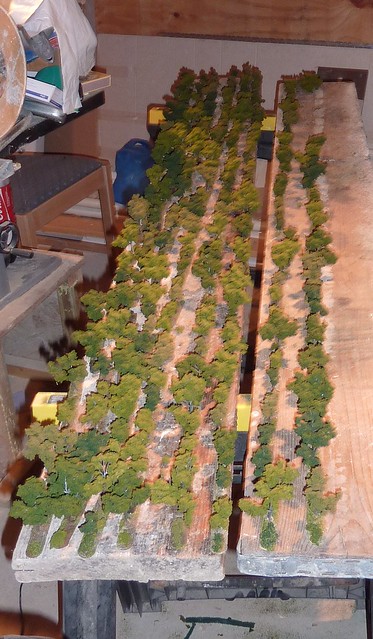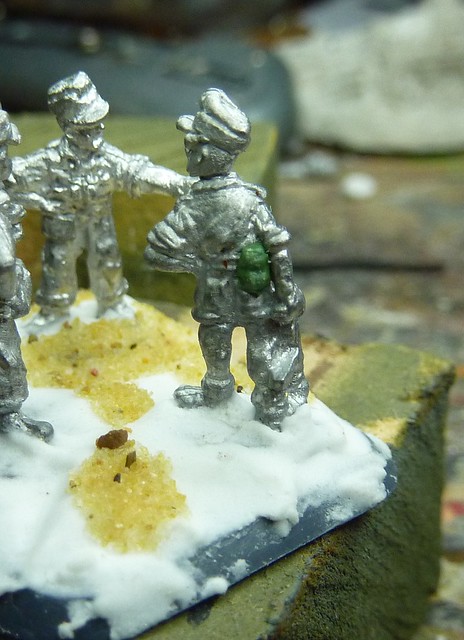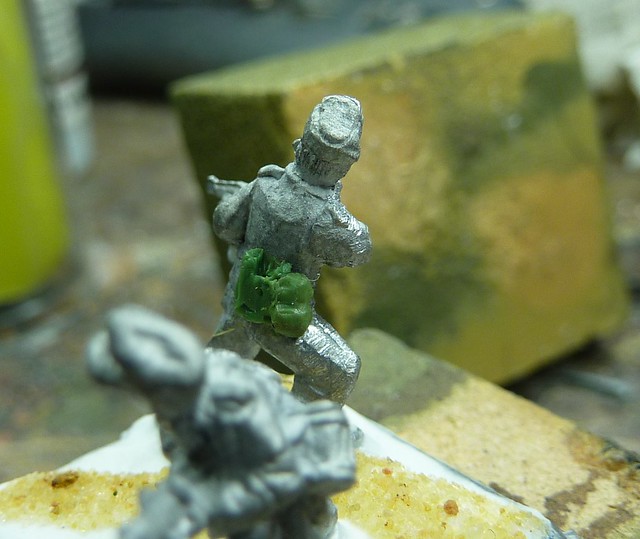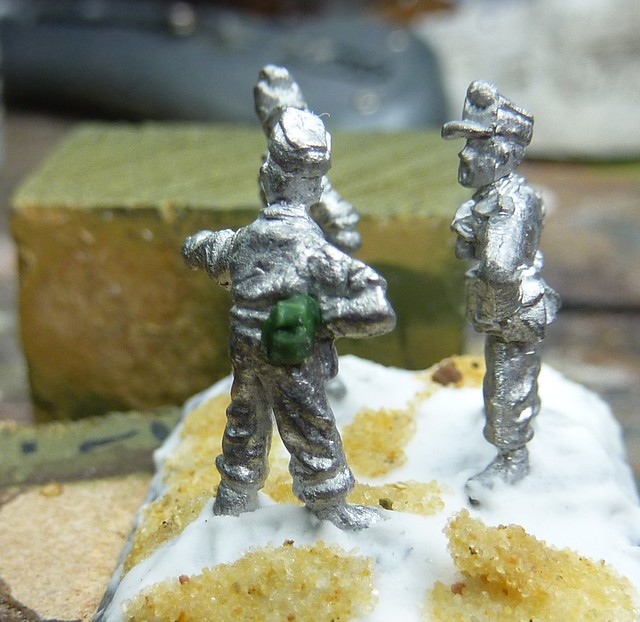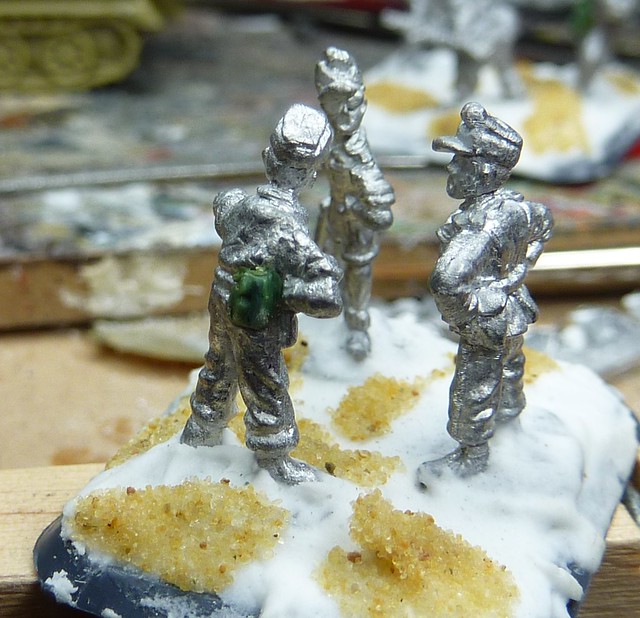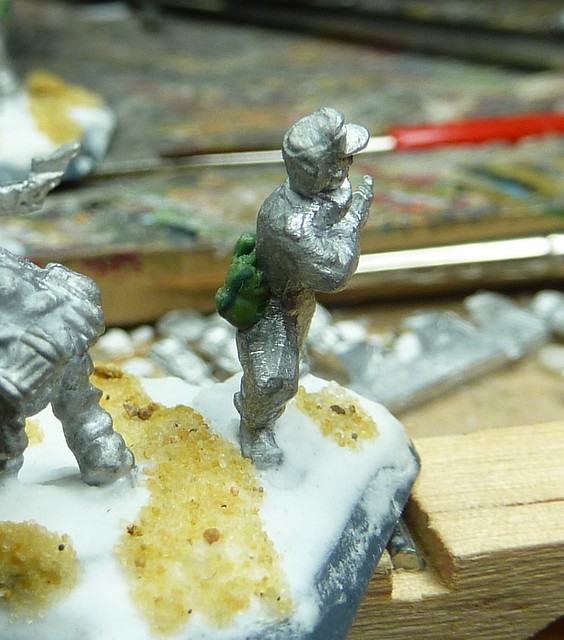This week in Dice Saloon, I return to Flames of War and look at the StG44 Assault Rifle, its history and its applications to the game.
Plus there's some pics of my newly finished VolksGrenadiers.
Friday 1 May 2015
Friday 3 April 2015
This week in the Wild West...
New post over at Dice Saloon.
This week I get tired of f-ing Dunjkelgelb and paint some cowboys.
Now back on Flames of War and working on a big pile of very late war Germans
This week I get tired of f-ing Dunjkelgelb and paint some cowboys.
 |
| Well technically Pinkertons... |
Now back on Flames of War and working on a big pile of very late war Germans
Monday 23 March 2015
I'm starting a new blog venture with the "Dice Saloon" guys as one of their writers.
I imagine Flames of War and its attendant painting projects will make up the bulk of the content but I also plan to talk about other games I play and aspects of the hobby. I'm not tying myself down to just being a painting blog so hopefully I'll be writing a lot more than I used to!
I have my introduction article up and another couple in the pipeline over the next week. There are some other familiar faces writing articles too, so keep a bookmark on this page and let us know what you think.
I imagine Flames of War and its attendant painting projects will make up the bulk of the content but I also plan to talk about other games I play and aspects of the hobby. I'm not tying myself down to just being a painting blog so hopefully I'll be writing a lot more than I used to!
I have my introduction article up and another couple in the pipeline over the next week. There are some other familiar faces writing articles too, so keep a bookmark on this page and let us know what you think.
Sunday 16 December 2012
Moving on Up
Hello,
As you can tell I'm still breathing. I also haven't been quite as idle as the blog would suggest.
The blog has presented an interesting challenge for me. I intended it to serve as a "behind the scenes" look at what I was doing, as well as serve as a log that i could look back on when I wanted to duplicate something later. Whilst it served in both roles I found out two things:
As you can tell I'm still breathing. I also haven't been quite as idle as the blog would suggest.
The blog has presented an interesting challenge for me. I intended it to serve as a "behind the scenes" look at what I was doing, as well as serve as a log that i could look back on when I wanted to duplicate something later. Whilst it served in both roles I found out two things:
- Blogs are time consuming. At least to write to the standard that i wanted to write. This took time away from actually doing the work in the first place.
- An idol blog is an albatross. If I didn't post anything it started gnawing at me. But I only liked posting when I was doing something interesting If all I'm doing is painting StuG platoon number 4 then what is going on the blog?
So, in the end the Blog fell by the wayside.
I'm hoping that not being the sole provider of content will make the blog more relaxing to write as I wont feel to need to work on filler. The level of content will stay the same on my part, but I will also be writing a bit more generally on wargaming outside of just modelling stuff.
In the meantime "Safety Markings" will go idle. Honestly, you won't notice the difference here given my lousy output in the recent months. If it all falls apart over there then I will likelly come back here and re-launch the blog.
Hopefully you will come and join me over at this new venture, the Brighton Warlords blog. I just posted my first entry that launches (pun intended) my new project, a V1 launch enclosure terrain piece.
Cheers,
Lee
Sunday 11 March 2012
Zimmer-it Up
It's always important to document the heroic failures as well as the successes so this week we'll take a look at an experiment I conducted with applying Zimmerit on 1:100 models.
Firstly, what is Zimmerit? It's an anti-magnetic mine paste that was applied to German tanks. If you've ever seen a German tank that looks like its got a bad case of cellulite, then that is Zimmerit. Here's a close-up photo I took of a JagdPanther at the Imperial War Museum, London that features it.
The paste is not anti-magnetic, it is just non-magnetic. It provides sufficient stand-off that a hand deployed panzer-knacker magnetic mine can't find purchase and will fall off. Based on this, the Geramns decided to apply it to all of their front-line tanks from the end of 1943. There was just one problem... Only the Germans used magnetic mines.
The Germans had, once again, made a massive assumption that everyone else would follow suite (like heavy tanks). Sadly the opposition's thought process went more or less like this:
Combined with a rumour that it caused tanks to catch fire (later disproved) it disappears off German armour production lines in September 1944. More info can be found here.
Now, the Plastic Soldier Company have been producing some fantastic plastic kits of late, but all the German kit is 'sans Zimmerit'. That's fine for stuff pre December '43 or post September '44 but, for the admittedly quiet bit in between, the models are technically incorrect.
So what's a boy working on an early 1944 army to do? There's two obvious choices here:
Looking at the patterns of Zimmerit used, I decided that the columns of horizontal lines (pattern 1 here) would be the easiest to replicate (although the waffle scheme - no.6 - was pretty common on StuGs and does look cool). I also decided to try three methods of replicating it:
I applied the green stuff to one location then used the sculpting tool to sculpt the lines in. If I was doing a whole tank I'd then proceed to do the next location, and so on, always sclupting the green stuff as soon as its applied and not letting it dry. As it was, I only did the one panel to assess the look.
To better show the panel off, I then painted it Vallejo "Middlestone", followed by a 50:50 Brown and Black shade followed by a "Buff" drybrush
I then waited for the green stuff to change to a darker shade of green all over (about 30 minutes). At this point I then set to work with the sculpting tool. One thing I noticed was that if I got the lines too close together, it tended to rip the green stuff off which may be useful as a technique for doing battle damaged zimmerit.
Here's what it looks like after painting
Here it is painted.
I painted up the Approach 2 example fully (or at least the modded area) to get a better look at the end result.
But, I'm still not convinced the end effect is worth it. The result is far too subtle and really just merges into the paint scheme. I'll probably stick to non-Zimmerit on the StuG battery but it does seem possible to apply it if it really bugs you.
I'd appreciate some feedback on this. Which do you think works better? Is it worth doing at all? Feel free to leave a comment below.
Firstly, what is Zimmerit? It's an anti-magnetic mine paste that was applied to German tanks. If you've ever seen a German tank that looks like its got a bad case of cellulite, then that is Zimmerit. Here's a close-up photo I took of a JagdPanther at the Imperial War Museum, London that features it.
 |
| Nothing a bit of moisturiser wouldn't solve. |
The paste is not anti-magnetic, it is just non-magnetic. It provides sufficient stand-off that a hand deployed panzer-knacker magnetic mine can't find purchase and will fall off. Based on this, the Geramns decided to apply it to all of their front-line tanks from the end of 1943. There was just one problem... Only the Germans used magnetic mines.
The Germans had, once again, made a massive assumption that everyone else would follow suite (like heavy tanks). Sadly the opposition's thought process went more or less like this:
- USA - Why'd I want to throw the mine when I can launch it on a rocket?
- Britain - Why'd I want to use a magnet when I can use glu-OH LORD! IT'S STUCK TO MY LEG!
- Russia - Why'd I want to use a mine when I can send wave after wave of my own men to use up their ammo?
 |
| Also, Dog Mines |
Now, the Plastic Soldier Company have been producing some fantastic plastic kits of late, but all the German kit is 'sans Zimmerit'. That's fine for stuff pre December '43 or post September '44 but, for the admittedly quiet bit in between, the models are technically incorrect.
So what's a boy working on an early 1944 army to do? There's two obvious choices here:
- Ignore it. At 1:100 the Zimmerit is barely visible beyond a slight surface patterning and a softening of the edges.
- Try and sculpt it on.
Looking at the patterns of Zimmerit used, I decided that the columns of horizontal lines (pattern 1 here) would be the easiest to replicate (although the waffle scheme - no.6 - was pretty common on StuGs and does look cool). I also decided to try three methods of replicating it:
- Paint on green stuff, sculpt lines as soon as applied
- Paint on green stuff, sculpt lines as soon as the green stuff darkens and dries
- Paint on green stuff, leave overnight, then sculpt in lines the next day.
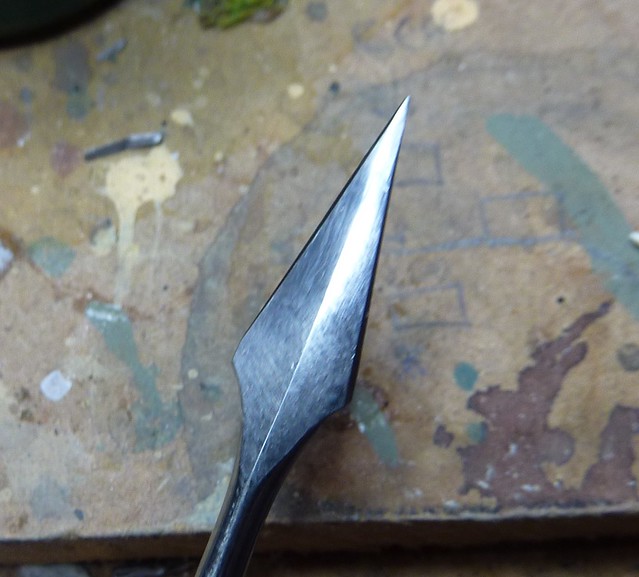 |
| Also, kind of looks like a xenomorpth tail |
Approach 1 - Wet Sculpt
I used a standard GW paint brush to apply some liquid breen stuff evenly over the armour plate. It's important to get the thickness right. The yellow plastic underneath should not be showing through. I applied the green stuff to one location then used the sculpting tool to sculpt the lines in. If I was doing a whole tank I'd then proceed to do the next location, and so on, always sclupting the green stuff as soon as its applied and not letting it dry. As it was, I only did the one panel to assess the look.
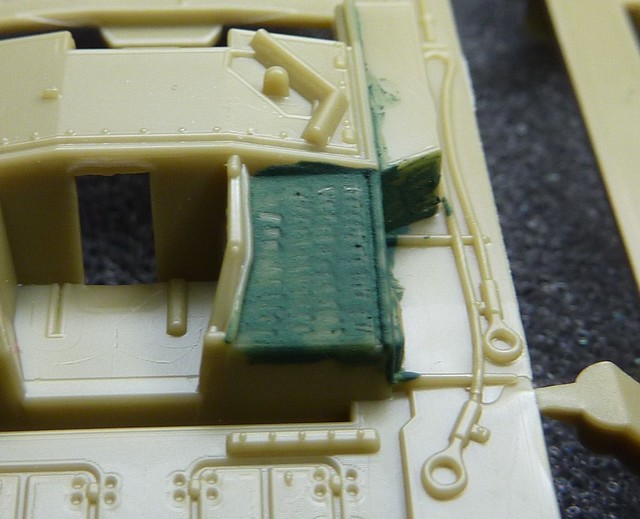 |
| Approach 1 - Sculpted straight after application |
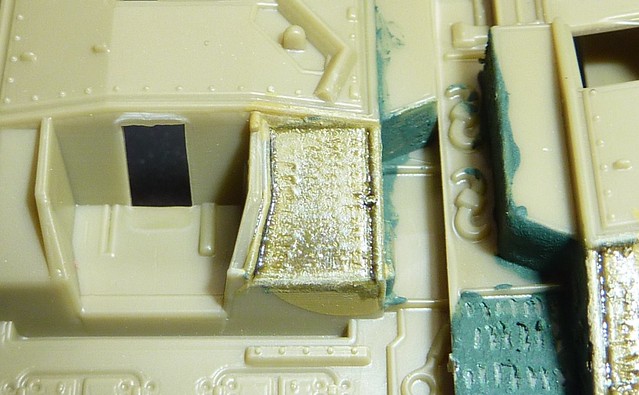 |
| Approach 1 - allowed to dry and painted |
Approach 2 - Short Dry Sculpt
I used the GW paint brush to apply liquid green stuff on all panels. I should not that the real zimmerit wasn't applied all over a tank (this large scale photo-etch kit shows where it should be), I just wanted plenty of area to experiment with.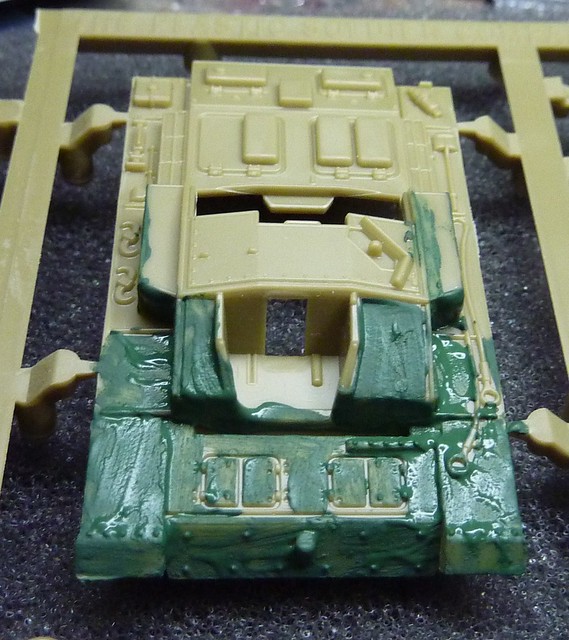 |
| Very reminiscent of my early "Space Crusade" era work. Thick, blotchy and un-even. |
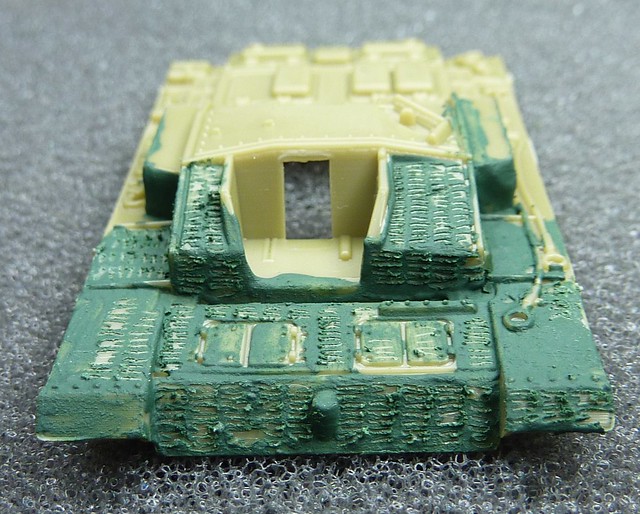 |
| Approach 2 - Green stuff applied all over and allowed to dry sufficient for colour to darken |
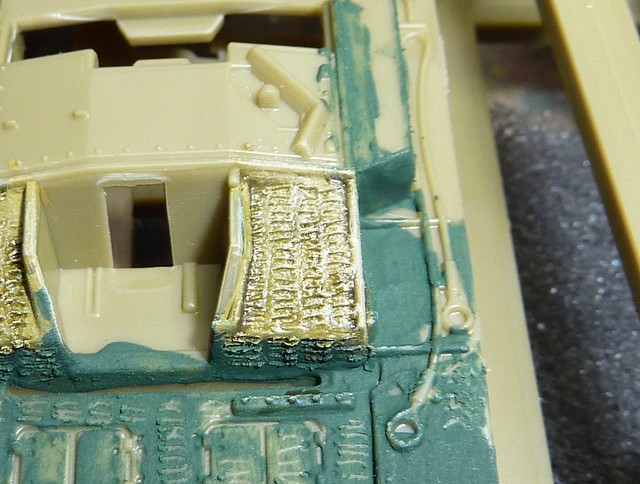 |
| Approach 2 - Painted |
Approach 3 - Long Dry Sculpt
The liquid green stuff was painted on at the same time as Approach 2 but left overnight. The next morning I used the sculpting tool to sculpt in the lines. I found that it was a lot harder to get a decent line as the tool tended to stick in the solid green stuff. Teraing seemed to be minimesd though.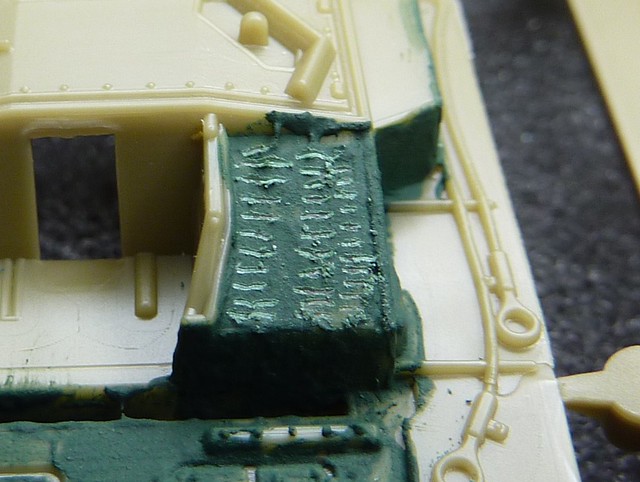 |
| Approach 3 - Allowed to dry overnight before working |
 |
| Approach 3 - Painted |
Conclusions
I'd have to say that Approach 2 works the best based on the painted results. It's also probably the faster approach to use too. Approach 1 is too slow to do and far too subtle. The texture does not come through the paint. Approach 3 was equally underwhelming and difficult to work.I painted up the Approach 2 example fully (or at least the modded area) to get a better look at the end result.
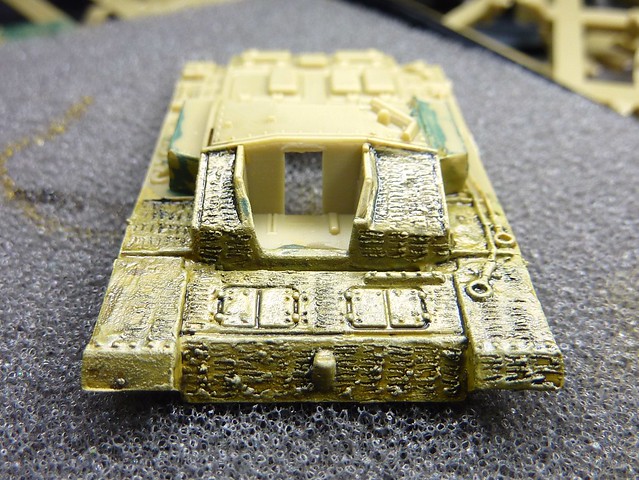 |
| As mentioned - Zimmerit wouldn't be on track skirts and lower hull top surface as I depicted here. So don't copy it! |
But, I'm still not convinced the end effect is worth it. The result is far too subtle and really just merges into the paint scheme. I'll probably stick to non-Zimmerit on the StuG battery but it does seem possible to apply it if it really bugs you.
I'd appreciate some feedback on this. Which do you think works better? Is it worth doing at all? Feel free to leave a comment below.
Labels:
15mm,
eastern front,
Flames of War,
greenstuff,
liquid greenstuff,
Miniatures,
Plastic Soldier Company,
StuG,
tutorial,
WWII,
Zimmerit
Wednesday 29 February 2012
Commence engine restart procedure
in 3... 2... 1...
Hmm, November 2nd was the last update you say? I guess I have some explaining to do...
Okay, so about November I really knuckled down on building terrain for the Brighton Bash Tournament. With the assistance of Mike and Nathan, over the course of November, December and the first few weeks of January we cracked out 40ft of tree lines and about 50ft of hedge rows along with some Ironclad Bocage sections and a Kerr and King village in a box! The likes of Skip, Steve B and Si also contributed.
The tournament seemed to go well and the terrain was well received. I took photos over the weekend which can be found here (photo-bucket uploaded them in reverse order annoyingly).
It took me a while to recover enthusiasm after that, but did eventually pick up the brush in late January to do some M3 Stuart I "Honey" tanks in Operation Crusader era Caunter camo. I took photos along the way and we'll look at them at some point in the future.
Finally, the release of the Grey Wolf and Red Bear source books for Flames of War got me looking at the Eastern Front with renewed interest. I picked up a few boxes of Plastic Soldier Company StuG III to form a Begleit StuG Battery and that really forms the basis for today's article. If your interested, I did a review on the StuG kit over at Mighty Miniatures.
I want the StuGs to be multi-purpose so they can be just as easily used as a Panzer Battalion equipped with StuG IIIG or as a Normandy era StuG Battery, neither of which have tanks riders. Now, I could just ignore the tank escorts when appropriate and leave them as a permanently fixed part of the tank, but that would be far too simple (as well as confusing if I don't upgrade all the platoons in the company to have Begleit). Instead, I want to magnetize the the riders and the tank to make them removable.
The main issue with this approach is the Begleit StuG riders. They come as a set of separate figures, rather than as a clump of figures (as the Russian equivalent do/did). Whilst this makes for a more versatile figure it does complicate the magnetisation process!
To get around this I decided to use a central piece of stowage to take the magnet, and then mount the figures from this, daisy chaining them if necceary. This would allow me to disperse the figures around the back of the tank whilst still keeping them as a single whole that could be lifted off as required.
Placing the magnet on the tank side was simplicity itself. A Ø1.5mm rare earth magnet (I used Modifix) would sit in between the engine covers of the StuG so the magnet on the tank would need to correspond to this location.
The plastic is thin enough to be semi-transparent. Holding the upper hull of the StuG up to a bright light, I scribed the corresponding point on the underside of the hull between the engine deck blisters and used this to glue a magnet in place.
It's important to keep all the magnets pointing the right way so I glued a magnet to a piece of stowage first and held that in place on the hull when gluing the one on the underside. The magnet on the underside will, when dropped into place, self locate AND make sure its pointing the right way.
That done, I completed the construction of the StuG's (an article in itself, maybe next week). The magnet on the tank is now completely out of sight.
The next stage is to play around with some blue tac and find a good pose for the tank riders. I use three or four of the Begleit models for each tank, positioning them around a crate, oil drum or other convenient piece of stowage that will accommodate a 1.5mm magnet.
Once happy, I use a 3mm drill bit in a dremel to drill a hole to locate the magnet. I then place the magnet on the hull (to ensure its up the right way), added a dab of super glue and then put the drilled stowage onto it. Keep moving the two bits so they can't get stuck to the hull!
It's now a case of pinning the Begleit to the stowage. Take one of the Begleit and dab a bit of bright paint (I use red) on it then push it against the stowage to transfer the paint over. This lets you work out where you should drill if its difficult to judge.
Now, use a 0.5mm/0.75mm drill to place a hole on both the Begleit and the stowage.
You now need a piece of metal wire to pin the two bits together. I use sandwich bag tie wraps as they tend to be about 0.5mm thick. Cut off an plastic covering and stick one end into one piece with some superglue. Once dry, cut to length and stick into the other piece.
A similar technique can be used to attach a Begleit to a Begleit already attached to the stowage ("daisy-chaining").
Once this is dry it should leave a cluster of Begleit and stowage that lifts clear of the hull like so:
The next stage will be to go back and add some green stuff tarps and bed rolls to hide the pins where I've needed to use long ones and also add some more stowage so it really looks like the Escorts are having to find somewhere to sit.
Of course, the magnet in the hull would also allow us to make "destroyed" smoke plumes or clusters of stowage (so the rear hull doesn't look empty without riders).
So there we go. Next update will either look at the finishing work on the escorts or tips on building the StuG kit depending how much work I get done! I'll try and get back into weekly updates too.
Hmm, November 2nd was the last update you say? I guess I have some explaining to do...
Okay, so about November I really knuckled down on building terrain for the Brighton Bash Tournament. With the assistance of Mike and Nathan, over the course of November, December and the first few weeks of January we cracked out 40ft of tree lines and about 50ft of hedge rows along with some Ironclad Bocage sections and a Kerr and King village in a box! The likes of Skip, Steve B and Si also contributed.
 |
| Kerr and King Normandy Buildings - Donated by Skip, base coated by Mike (along with FFI graffiti), fine detail and frontage by me. |
The tournament seemed to go well and the terrain was well received. I took photos over the weekend which can be found here (photo-bucket uploaded them in reverse order annoyingly).
It took me a while to recover enthusiasm after that, but did eventually pick up the brush in late January to do some M3 Stuart I "Honey" tanks in Operation Crusader era Caunter camo. I took photos along the way and we'll look at them at some point in the future.
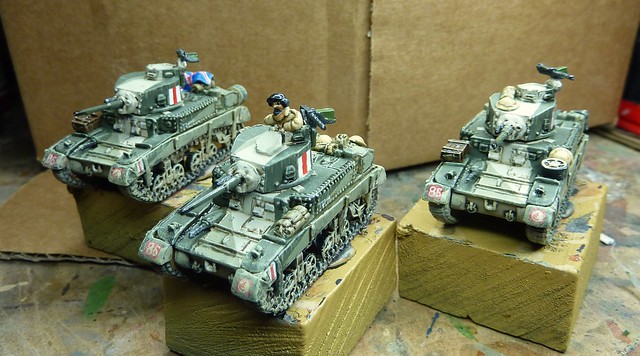 |
| Ready to stroll around the blue! |
I want the StuGs to be multi-purpose so they can be just as easily used as a Panzer Battalion equipped with StuG IIIG or as a Normandy era StuG Battery, neither of which have tanks riders. Now, I could just ignore the tank escorts when appropriate and leave them as a permanently fixed part of the tank, but that would be far too simple (as well as confusing if I don't upgrade all the platoons in the company to have Begleit). Instead, I want to magnetize the the riders and the tank to make them removable.
The main issue with this approach is the Begleit StuG riders. They come as a set of separate figures, rather than as a clump of figures (as the Russian equivalent do/did). Whilst this makes for a more versatile figure it does complicate the magnetisation process!
To get around this I decided to use a central piece of stowage to take the magnet, and then mount the figures from this, daisy chaining them if necceary. This would allow me to disperse the figures around the back of the tank whilst still keeping them as a single whole that could be lifted off as required.
Placing the magnet on the tank side was simplicity itself. A Ø1.5mm rare earth magnet (I used Modifix) would sit in between the engine covers of the StuG so the magnet on the tank would need to correspond to this location.
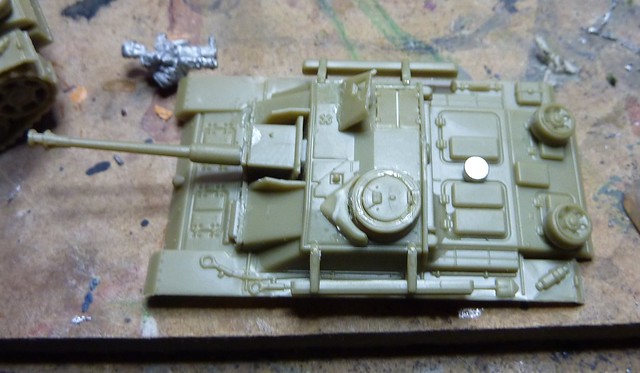 |
| Almost made to measure! |
 |
| Stealth Mode Initiated! |
 |
| If you look closely you can see where the magnet dragged itself into place |
The next stage is to play around with some blue tac and find a good pose for the tank riders. I use three or four of the Begleit models for each tank, positioning them around a crate, oil drum or other convenient piece of stowage that will accommodate a 1.5mm magnet.
Once happy, I use a 3mm drill bit in a dremel to drill a hole to locate the magnet. I then place the magnet on the hull (to ensure its up the right way), added a dab of super glue and then put the drilled stowage onto it. Keep moving the two bits so they can't get stuck to the hull!
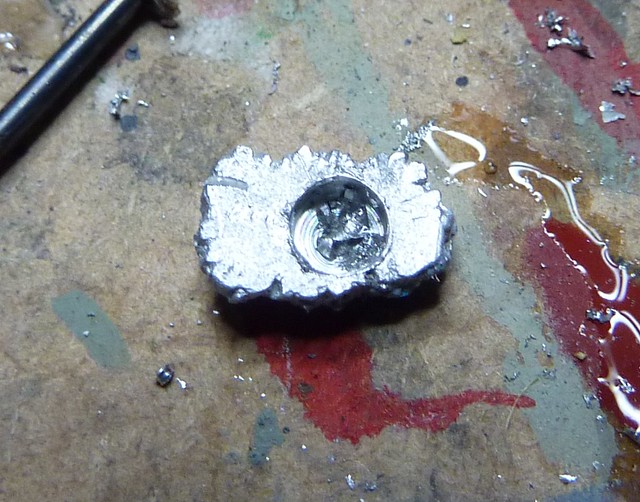 |
| It's obviously important to make sure that the stowage is bigger than a 3mm hole... |
Now, use a 0.5mm/0.75mm drill to place a hole on both the Begleit and the stowage.
You now need a piece of metal wire to pin the two bits together. I use sandwich bag tie wraps as they tend to be about 0.5mm thick. Cut off an plastic covering and stick one end into one piece with some superglue. Once dry, cut to length and stick into the other piece.
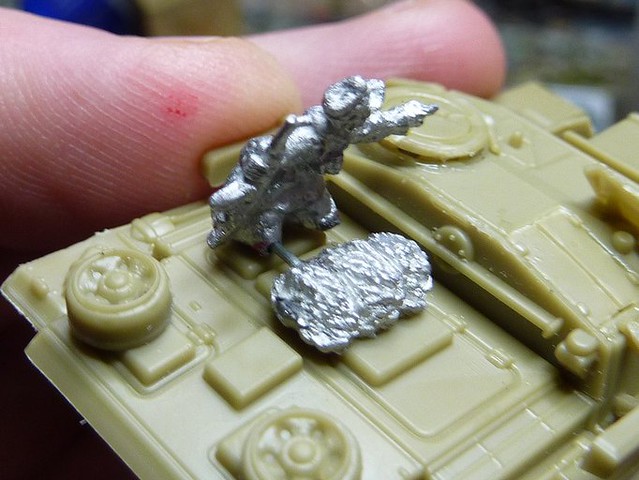 |
| The very definition of "being pinned" |
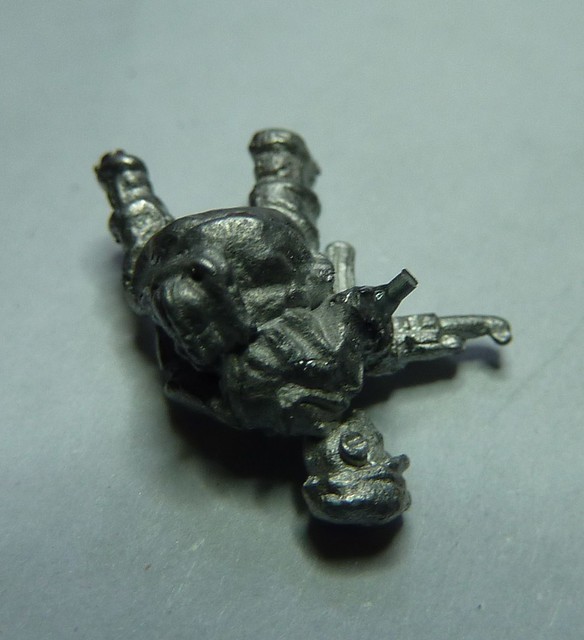 |
| Oooh, nasty! |
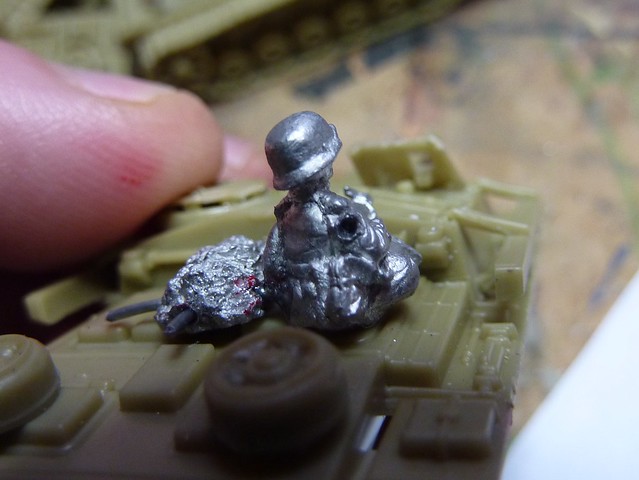 |
| As can be seen, a similar technique can be used for 0.50 cal exit wounds... |
 |
| <sing>"here I am, stuck in the middle with you"</sing> |
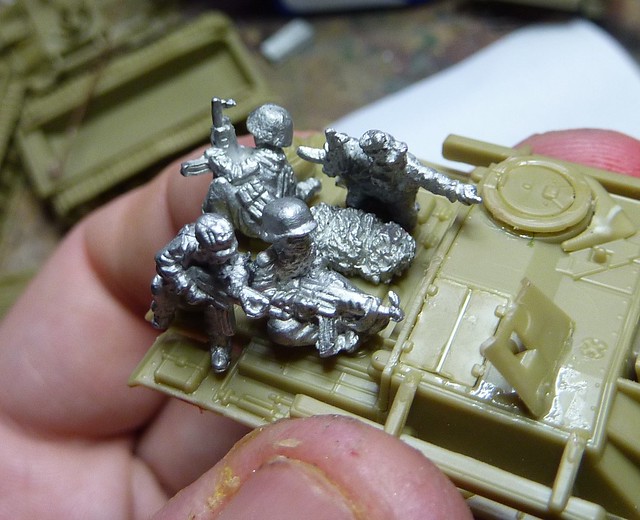 |
| All ready to keep them damn ruskies off the StuG |
 |
| "Stealth Mode Ini.. wait. What do you mean it doesn't work on the escorts?" |
The next stage will be to go back and add some green stuff tarps and bed rolls to hide the pins where I've needed to use long ones and also add some more stowage so it really looks like the Escorts are having to find somewhere to sit.
Of course, the magnet in the hull would also allow us to make "destroyed" smoke plumes or clusters of stowage (so the rear hull doesn't look empty without riders).
So there we go. Next update will either look at the finishing work on the escorts or tips on building the StuG kit depending how much work I get done! I'll try and get back into weekly updates too.
Labels:
15mm,
Battlefront,
Begleit,
eastern front,
Flames of War,
greenstuff,
Miniatures,
Plastic Soldier Company,
removable tank riders,
StuG,
tutorial,
WWII
Wednesday 2 November 2011
Green(stuff) Piece
Hello,
Just a quick update. I had started writing this entry a few weeks ago to kill time on a business trip. Finally got around to finishing it off now. I had made a start on the hedges for the tournament but I've had some difficulty getting a straight cut and need some fatherly assistance. sadly he's still in Devon on his holidays...
A few years ago, BF used to put a tank crewman in with each tank and these were great little figures, generally either a wounded crewman clutching his arm or a more... pro-active one clutching a sub-machine gun like he's going to hunt down the ATG that just brewed him up. The German's also got a pretty neat one of one crewman dragging a dazed comrade forward. At some point BF stopped putting them in the Blister which was annoying but I had managed to build quite a stock pile of Brit and German ones anyway, with a few given by other guys in the club who didn't use them.
Now, I typically use them to show a tank is baled/bogged by sticking one on a penny (I used to try and get a full crew onto a small base) and I have used one as the basis for a tank commander previously, but I was running short of DAK figures to finish off my command bases and I thought, "why not just use some of the SMG armed ones?"
There are two figures that wouldn't look out of place on a DAK base. One has the DAK style peaked soft cap, goggles and shorts with MP40 by his side whilst the other is emptying his SMG towards the enemy. Really, the only thing they really need is some webbing (canteen, maybe the bread bag too) to make them blend in with the infantry/guns they are leading.
I'm no sculpter but I have had a stab at using green stuff in conversions before, such as the aforementioned tank commander.
Compared to that, a canteen and bread bag seemed pretty simple!
Firstly, I looked over some reference material (google searches, looking at other DAK figures) to try and work out how the webbing should look. It's important to get the big detail (relative size, shape, position) right because no amount of fine detail will hide a major boo-boo like getting the canteen stupidly big or on the wrong side!
Here's how it should look:
The next thing is to work out how the sequence. We need to work outwards with the greenstuff so its Bread Bag, then Canteen, then the strap of the canteen that holds the cup on (the metal cup of the canteen will just be a simple line break on the canteen shape).
Next, I knock up some green stuff into a 50:50 ratio. I recall an old White Dwarf article saying to use half of what you think you need and it has always seemed good advice; I always seem to mix too much, even then.
No doubt modern White Dwarf would tell you to mix three times as much as you think you need!
The bread bag is fairly simple to do. I roll out some green stuff onto a wet tile (greenstuff doesn't stick well to wet things. So keep blades and fingers damp!) and, using an existing model as a reference, cut out a thick rectangle of about the right size for a bread bag.
Now, using a wet blade, lift the rectangle off the pallet and place on the right rear side of the model (again, worth checking a reference when doing it). I let it sit for about half an hour to partly cure then used a sculpting tool to remove the material between where the belt loops sit, add an indent around the edge to represent the breadbag's front and add two indents for the buckles.
It's important not to rush things so I left the bag to cure overnight.
Next I worked on the canteens. I mixed up some more green stuff and formed it into a tear drop size about the size of the canteen (including cup). This was placed over the breadbag (if present) and allowed to sit for about thirty minutes. I then flattened the top down to square off the cup and indented a line to show where the cup meets the canteen.
I left that to cure fully and pondered the next step. I needed a strap to join the canteen to the cap/cup. However, after a few attempts I had to admit that such a fine strap was just out of my ability. Thankfully I spotted a post by one of my fellow Brighton Warlords, Ade over at Restless Wargamer. He had been playing around with a GW product called liquid greenstuff with great effect. Luke at Onslaught Games had some in stock so, on a whim, I grabbed a bottle.
It's pretty neat stuff. It can be picked up by brush and can then be cleaned off in water with little impact to the brush afterwards. It seems to be aimed at patching up finecast models but I decided to experiment and tried "painting on" the strap, like painting a fine line. This seemed to go well, but wasn't quite as defined as much as I wanted. Once it cured, I painted on another layer and this seemed to do the trick. Once it cured, I cut the strap square at the bottom and did some mild filing to get the strap flat but otherwise it required very little work.
So there we go, some relatively simple greenstuffing converts spare tank crews into interesting alternative DAK infantry/commander.
Just a quick update. I had started writing this entry a few weeks ago to kill time on a business trip. Finally got around to finishing it off now. I had made a start on the hedges for the tournament but I've had some difficulty getting a straight cut and need some fatherly assistance. sadly he's still in Devon on his holidays...
A few years ago, BF used to put a tank crewman in with each tank and these were great little figures, generally either a wounded crewman clutching his arm or a more... pro-active one clutching a sub-machine gun like he's going to hunt down the ATG that just brewed him up. The German's also got a pretty neat one of one crewman dragging a dazed comrade forward. At some point BF stopped putting them in the Blister which was annoying but I had managed to build quite a stock pile of Brit and German ones anyway, with a few given by other guys in the club who didn't use them.
Now, I typically use them to show a tank is baled/bogged by sticking one on a penny (I used to try and get a full crew onto a small base) and I have used one as the basis for a tank commander previously, but I was running short of DAK figures to finish off my command bases and I thought, "why not just use some of the SMG armed ones?"
There are two figures that wouldn't look out of place on a DAK base. One has the DAK style peaked soft cap, goggles and shorts with MP40 by his side whilst the other is emptying his SMG towards the enemy. Really, the only thing they really need is some webbing (canteen, maybe the bread bag too) to make them blend in with the infantry/guns they are leading.
I'm no sculpter but I have had a stab at using green stuff in conversions before, such as the aforementioned tank commander.
Compared to that, a canteen and bread bag seemed pretty simple!
Firstly, I looked over some reference material (google searches, looking at other DAK figures) to try and work out how the webbing should look. It's important to get the big detail (relative size, shape, position) right because no amount of fine detail will hide a major boo-boo like getting the canteen stupidly big or on the wrong side!
Here's how it should look:
The next thing is to work out how the sequence. We need to work outwards with the greenstuff so its Bread Bag, then Canteen, then the strap of the canteen that holds the cup on (the metal cup of the canteen will just be a simple line break on the canteen shape).
Next, I knock up some green stuff into a 50:50 ratio. I recall an old White Dwarf article saying to use half of what you think you need and it has always seemed good advice; I always seem to mix too much, even then.
No doubt modern White Dwarf would tell you to mix three times as much as you think you need!
The bread bag is fairly simple to do. I roll out some green stuff onto a wet tile (greenstuff doesn't stick well to wet things. So keep blades and fingers damp!) and, using an existing model as a reference, cut out a thick rectangle of about the right size for a bread bag.
Now, using a wet blade, lift the rectangle off the pallet and place on the right rear side of the model (again, worth checking a reference when doing it). I let it sit for about half an hour to partly cure then used a sculpting tool to remove the material between where the belt loops sit, add an indent around the edge to represent the breadbag's front and add two indents for the buckles.
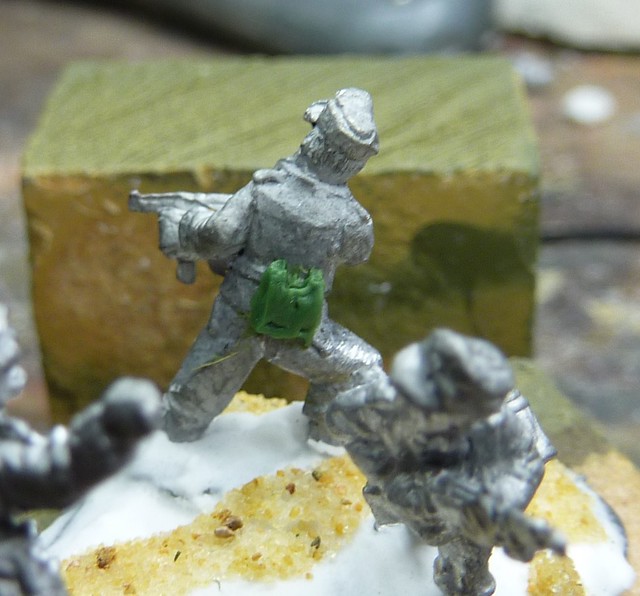 |
| Not modelled - Bread |
Next I worked on the canteens. I mixed up some more green stuff and formed it into a tear drop size about the size of the canteen (including cup). This was placed over the breadbag (if present) and allowed to sit for about thirty minutes. I then flattened the top down to square off the cup and indented a line to show where the cup meets the canteen.
I left that to cure fully and pondered the next step. I needed a strap to join the canteen to the cap/cup. However, after a few attempts I had to admit that such a fine strap was just out of my ability. Thankfully I spotted a post by one of my fellow Brighton Warlords, Ade over at Restless Wargamer. He had been playing around with a GW product called liquid greenstuff with great effect. Luke at Onslaught Games had some in stock so, on a whim, I grabbed a bottle.
It's pretty neat stuff. It can be picked up by brush and can then be cleaned off in water with little impact to the brush afterwards. It seems to be aimed at patching up finecast models but I decided to experiment and tried "painting on" the strap, like painting a fine line. This seemed to go well, but wasn't quite as defined as much as I wanted. Once it cured, I painted on another layer and this seemed to do the trick. Once it cured, I cut the strap square at the bottom and did some mild filing to get the strap flat but otherwise it required very little work.
So there we go, some relatively simple greenstuffing converts spare tank crews into interesting alternative DAK infantry/commander.
Labels:
15mm,
Battlefront,
DAK,
Flames of War,
greenstuff,
liquid greenstuff,
Miniatures,
North Africa,
sculpting,
tutorial,
WWII
Subscribe to:
Posts (Atom)




